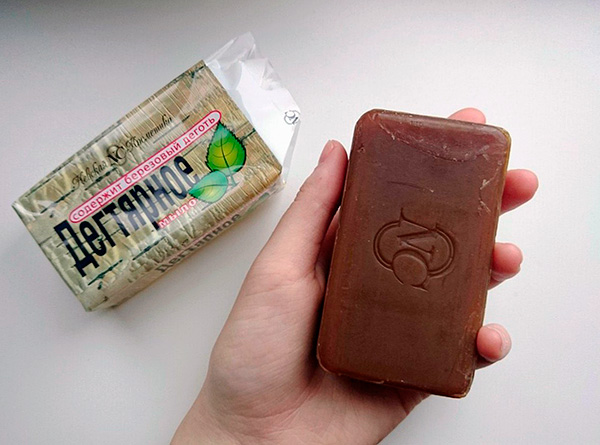
Tar soap as a remedy for fleas is traditionally considered as a harmless and natural alternative, although quite effective, but not always safe for cats and dogs to modern preparations based on synthetic insecticides. At the same time, tar soap has become popular among people as a reliable antiparasitic agent, and many pet owners are seriously convinced that to effectively combat fleas it is only necessary to suffer the unpleasant smell of tar once or twice, providing their pet a bath with this soap.
In fact, everything is somewhat more complicated ...
The fact is that, in general, against fleas, tar soap is significantly less effective than drops, sprays, powder and collars containing fipronil, deltamethrin, imidacloprid, diflubenzuron and other powerful insecticides that are sold today in pharmacies.And in order to save your pet from parasites with the help of tar soap, you will have to spend more time and effort than with the use of specially designed tools.

Nevertheless, if it is primarily the safety of the animal that is at the forefront, then it is quite reasonable to use tar soap. This is especially true when breeding fleas in cats (they are generally more susceptible to insecticides than dogs), as well as in weak animals, pregnant or lactating females.
Security implies, among other things, a low probability of side effects, which are far from uncommon for various insecticidal drops and sprays. Here are typical examples of adverse effects from the use of insecticidal drugs:
Feedback on the use of anti-flea drops:
“... No need to extol these drops. I applied them to a cat and a kitten. With the cat, fortunately, everything is fine, but the kitten does not get up for the second day, does not eat anything, it meows only when you touch it. It feels like it hurts when touched. I processed it according to the instructions, I bought drops in a veterinary pharmacy ... Now my conscience torments me,that I almost killed the kitten myself, but I’ve only recently jumped and played ... "
Elena, Saint Petersburg
And one more tip about using flea drops:
“I bought flea droplets from my cat. Has caused. Oh dear, what started here! Worn around the house, like a mad, wildly yelling! Trying to lick ... "
Svetlana, Samara
Thus, the problem of safely removing fleas in cats and dogs is far from far-fetched, and in this respect tar soap is indeed of interest. About what needs to be taken into account, in order to save his four-legged friend from fleas with his help, we will go on and talk in more detail ...
Tar soap as an insecticide
Generally speaking, tar tar soap insecticide can only be a stretch. The main component of this soap - birch tar (contained in an amount of about 10% by weight) - is not able to quickly and effectively kill insects, including fleas, even with direct contact with the covers of their bodies.

On a note
Birch tar contains some phenol, cresol and other toxic compounds that can have a detrimental effect on living organisms with prolonged exposure.However, the poisoning effectiveness of tar soap is tens (or even hundreds) times lower than that of the specialized modern insecticides (for example, from the pyrethroid class).
At the same time, a pronounced deterring effect of tar soap on most insects is known. Birch tar itself has long been used as a repellent in horticulture, and in ancient times people who lived in the taiga, used tar to protect against mosquitoes and nasal debris.
The photo below shows birch tar:

Indeed, both tar and tar soap prepared with its use have a very strong peculiar smell. Many people find it unpleasant, although it is rather a consequence of a high concentration of tar in soap (about 10%). But it is the smell that helps repel insects, including fleas, and not some other properties of tar.
In this case, a reasonable question may arise: how then did it happen that tar soap was widely and long used to remove lice in humans? After all, lice can not be scared away - they can not, like fleas, jump off the head, wait for some time on the floor or in things, and then again attack a person.Head lice can live only in the human hair, and falling from them, the parasites have died for several hours.
It turns out that if tar soap helps against lice, it means that it is still capable of killing insects - which means it will also help against fleas?
The point here is that tar soap against lice practically does not help. Traditionally, they have been treated for various skin diseases, including those on the head - tar really helps to speed the healing of scratches, wounds, various scuffs, and it also reduces the itching of insect bites. And it is not surprising that they washed head with soap with soap with head lice - when biting lice, itching is the same as with many other dermatological diseases.
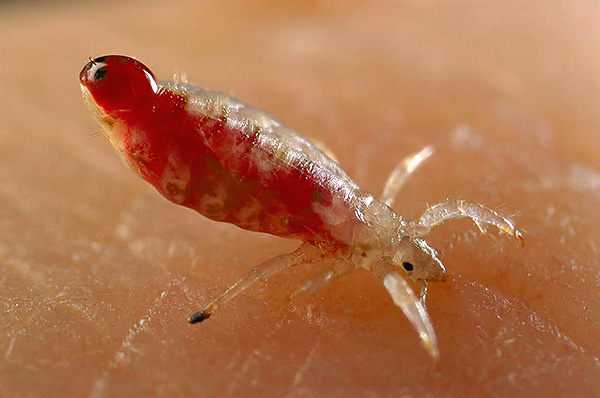
That's just this tar soap was not initially considered as a remedy for lice, but was used primarily to alleviate the unpleasant symptoms caused by parasite bites. However, over time, the tradition of using tar soap with lice has settled, and a myth has emerged that this tool helps to effectively deal with lice. And then - more: if tar lice “poison” lice, then you can poison and fleas in cats and dogs ...
In fact, there are no prerequisites for the fact that fleas can be poisoned with tar soap. In literary sources there is no mention of the insecticidal activity of either tar or soap from it - only studies were conducted that confirmed the presence of pronounced antiseptic efficacy in tar (that is, it is capable of killing bacteria).
However, the use of tar soap sometimes really helps to remove fleas. At a minimum, because fleas are afraid of the smell of tar, and these parasites, unlike lice, are more mobile and can easily leave the animal's fur. So, if used correctly, tar soap can be considered as a safer (but less effective) alternative to modern flea drugs.

Feedback
“Help solve the problem. There is a cat, home, neutered. It is obviously a flea. The ears themselves are torn to the blood. I bought him Frontline drops, which seem to be super efficient. Kapnula, followed on his heels, so that he did not comb there and licked. For three days he did not seem to be worried, and then again began to itch. Redeemed in tar soap. No effect at all, only the wool became harder.Scratching and never stopped. Now I think what needs to be done to rid the poor man of these parasites. If such expensive drops didn’t help, what would help? ”
Zhenya, Tver
A few words about the properties of tar soap
In addition to a strong and not very pleasant smell, tar soap has some more characteristic properties:
- The soap itself is brown (in some manufacturers it is similar in color to chocolate);

- When applied to the hair "dries" them, actively emulsifying the fat (it should be borne in mind that some cats are not desirable to bathe with means, drying wool);
- It has some antibacterial and wound-healing effect. Due to this, tar soap is sometimes recommended to wash your hair with seborrhea, and tar is part of the well-known healing wounds ointment (Vishnevsky, Wilkinson);
- It foams poorly, so it is difficult to use it as a substitute for ordinary soap;
- Able to soothe itching from flea bites.
Another important feature of tar soap is its low price. One piece of it, which is quite enough for a few bathing animals, costs about 50 rubles (although in online stores you can find various versions of this soap, worth up to 600 rubles). Liquid soap with tar (or shampoo) is also suitable for removing fleas.
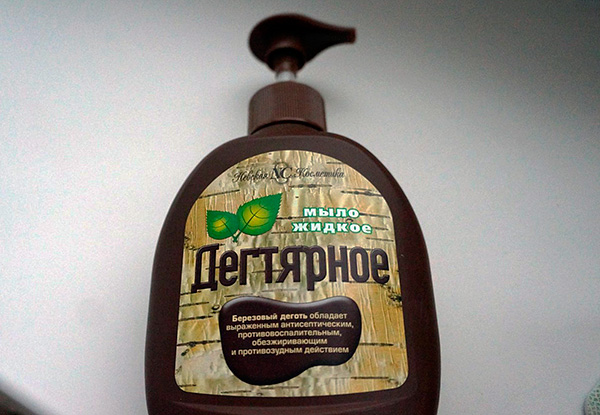
Given the availability and low cost, tar soap can be tried to use against fleas as a first means, and if it does not help, then use a specialized more powerful tool containing synthetic insecticides. In addition, tar soap can be used in addition to other drugs, especially considering that it is safe even for kittens and puppies.
How safe is the use of this soap, including puppies and kittens?
Tar soap when used very rarely causes even minor side effects.
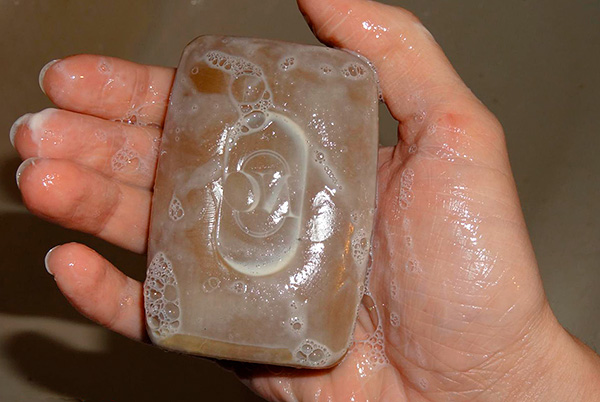
In addition to drying the skin and coat of the animal, the tar in the soap composition can rarely cause allergic reactions. However, this risk can be called purely hypothetical, because today there are no known cases of severe allergy to this remedy in animals, they are described only in humans. It is noted that such allergic reactions are extremely rare.
Most likely, specifically in your case, neither the dog nor the cat (including a puppy or kitten), tar soap will not cause any side effects.
Feedback
“I heard a lot about the benefits of tar soap, but I really do not like the smell.I only bring them fleas from the dog, she sometimes finds them on the street when she plays with other dogs. Previously, I used imported shampoos, and recently tried tar soap on the advice of the seller. It turned out that it is about as effective. After 1-2 swims, the fleas completely disappear, the dog feels well. "
Olya, Moscow
The procedure for removing fleas in dogs and cats using tar soap
So, in order to remove fleas in an animal using tar soap, one should proceed according to the following scheme:
- Pet must be put in the bathroom, a little filled with warm water;
- All animal hair is rinsed with clean water until it gets wet;
- The animal is thoroughly soaped with tar soap to obtain foam. It is highly desirable to lather, including the head, otherwise a part of the fleas will simply move here and wait out the whole water procedure on the dry hair of the head.;
- Then the foam is washed off with clean water (already at this stage, part of the fleas will be washed down the drain);
- The procedure is repeated, but this time after beating the foam, the animal should be allowed to sit with it for 5-7 minutes;
- At the end of the procedure, the animal's coat is rinsed with clean water several times, after which you can wipe the pet with a towel.

About 1-2 days after bathing, the animal's fur will continue to smell of tar (especially cats that have a less pronounced aroma of their own smell). Due to the smell of flea tar on a pet during this period will not jump, and at this time it makes sense to deal with fleas in the house.
Such bathing with tar soap is desirable to spend 2-3 times with an interval of 4-5 days. If measures are taken in parallel to destroy fleas in the room, then at the end of such a struggle, neither the animal nor the parasite house will be left.
Feedback
“They were very surprised when a flea was found in an absolutely domestic cat. I do not know where he took them from. Maybe we brought this from the street. I put all of his bedding in the laundry, and the cat in the bathroom, all of it was washed with tar soap. It was evident that he did not like it very much, but he was calm with me, he endured it. Washed away, let go. I thought that for a long time stink would be tar, but no, the smell quickly evaporated. Two days later I washed it again. And that's all, there are no more fleas. ”
Elizaveta, Moscow
An integrated approach to the fight against fleas (including in the apartment)
It is very important to remember that fleas can leave the animal's hair and for quite a long time live in an apartment outside the body of a cat or dog. Moreover, they can bite people for a rather long time and feed on their blood, and their small worm-like larvae can develop in garbage, in crevices behind plinths, in piles of dust, in bedding of an animal, and even in flower pots - everywhere where there is at least some it is organic that you can eat.
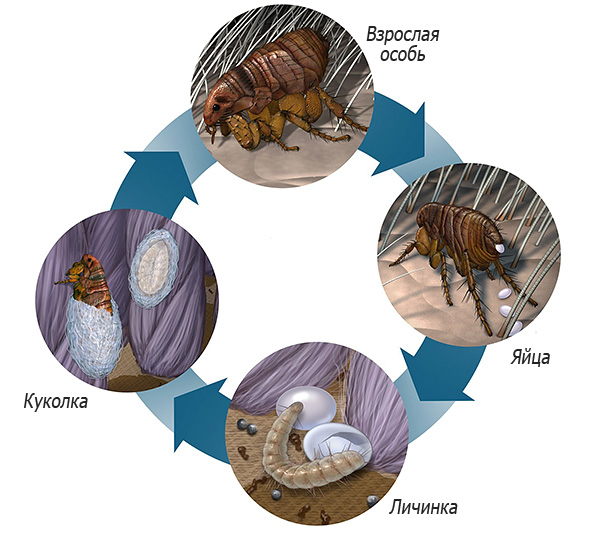
Consequently, although the animal can be eliminated from fleas using tar soap (or other means), but if the parasites remain in the house, then they will be able to attack the pet again at any time, and everything will return to normal. To avoid this, after removing fleas in an animal, it is necessary to take measures to get rid of the parasites in the apartment itself.
For this you need:
- To conduct a thorough disinsection of the premises with the help of special insecticidal preparations (not those with the help of which they remove fleas in cats or dogs, but intended specifically for the treatment of premises from insects - these can be aerosol preparations or powders);
- The dirtiest places in the room should be thoroughly cleaned, and it is also advisable to dust them with insecticide dust (to destroy flea larvae). These include spaces under the bathroom, wet corners on unheated balconies, slits behind baseboards, lower shelves in the closet, etc .;
- If within 5-6 days after the last bathing of the animal and the disinsection in the room, neither people nor the pet are disturbed by the flea, it can be concluded that tar soap and additionally taken measures helped to get rid of parasites.
Pet after getting rid of fleas, it is desirable to display on the street in a special anti-flea collar, which will protect him from repeated attacks of parasites. In the house, this collar can be removed so that it does not burden the pet.
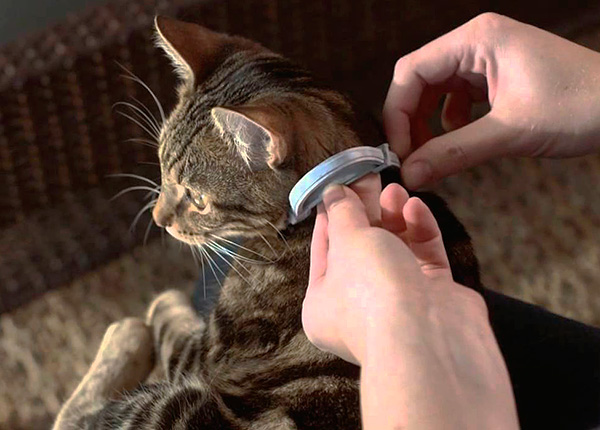
Feedback
“A neighbor advised me to bathe the dog (Bernese Mountain Dog) with tar soap to save it from fleas. And then she, poor fellow, literally to the blood itself combed because of their bites. In general, a penny tool turned out, 40 rubles worth one piece of soap. Already after the first bathing, the fleas became clearly smaller, almost did not itch. After the fifth swim, all the fleas disappeared. Now every month I bathe once a dog with tar soap. She constantly lives on the street in the summer, and there are no fleas on her. ”
Alyona, Saratov
If you have experience in the use of tar soap for removing fleas - be sure to share the information by leaving your review at the bottom of this page (in the comments box).
An example of bathing cats with tar soap
Useful video about different types of drugs for fleas and ticks - which is more effective?




They advised a flea pill in the veterinary hospital, dear (about 600 rubles), protection for a month: frontline nexgard. The dog gladly ate this pill. Processed with a special solution room.Fleas are still there, the dog continues to itch - less, but nonetheless. On the street we walk in an anti-flea collar. I will try to bathe with tar soap.
Redeemed a puppy with tar soap. Fleas right out of the wool began to climb out. It seems not to itch.
Thank you very much! I learned a lot about tar soap and today I will start bathing my dogs! After the summer, of course, every domestic dog can pick up fleas, they certainly need to display.
Just bought a teenage kitten with tar soap. Fleas from the soap, as it were, become numb, and those who have not washed off when bathing, it is easy to choose directly from the wool, especially in the area of the nose and eyes (they are trying to hide there). She soaped soap three times, each time she held for about 2 minutes, the kitten could not stand more and started yelling and scratching ... After a week we will repeat the procedure. We will defeat them =)
Thank you very much for the useful information.
I bought my Yorkshire terrier puppy, he is 1.5 months old. Fleas died while bathing. The baby does not itch, he has become calm. Very many thanks, who makes this wonderful soap.